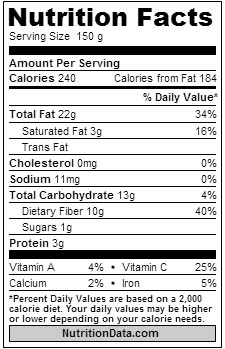You probably know that avocados are an excellent source of healthful fats, but this whole food contains other unique health benefits.The Hass Avocado Board (HAB) has been supporting clinical research investigating the various health effects of avocado consumption, particularly its benefits for cardiovascular disease, weight management, diabetes, and its ability to enhance the body’s absorption of nutrients.
Avocados, which are actually classified as a fruit, are rich in monounsaturated fat that is easily burned for energy. I eat an avocado nearly every day; this increases my healthy fat and calorie intake increasing my protein or carbohydrate intake. (See Nutrition Facts Panel below.) It is also very high in potassium. Eliminating grain carbs is one of the best ways to support your health and maintain your weight, but when you cut down on carbs, you need to increase your intake of healthy fats. Avocados are an excellent source, along with organic raw butter, coconut oil, olive oil and organic pastured eggs.Overall, most people would do well to get upwards of 50-70 percent fat in their diet (along with high amounts of vegetable carbs, moderate-to-low amounts of high-quality protein, and very little, if any, carbs). Avocados are high in:
- Fiber
- Potassium (more than twice the amount found in a banana)
- Vitamin E
- B-vitamins
- Folic acid
Avocados are one of the safest fruits you can buy conventionally-grown,and most experts do not believe you need to purchase organic ones. Their thick skin protects the inner fruit from pesticides.
Avocados have a long list of potential health benefits. For example, besides its anti-inflammatory properties, previous research from Japan suggests this powerful fruit may also help protect against liver damage.Due to its beneficial raw fat content, avocado enables your body to more efficiently absorb fat-soluble nutrients (such as alpha- and beta-carotene and lutein) in other foods eaten in conjunction, which help protect your body against free radical damage.
To preserve the area with the greatest concentration of antioxidants, you basically want to peel the avocado with your hands, as you would a banana:
- First, cut the avocado length-wise, around the seed
- Holding each half, twist them in the opposite directions to separate them from the seed
- Remove the seed
- Cut each half, lengthwise
- Next, using your thumb and index finger, simply peel the skin off each piece
While avocado is commonly eaten raw, on salad or alone, with nothing but a dash of Himalayan salt and some ground pepper, for example, there are many other ways to include avocado in your diet. For example, you can use avocado in the following ways:
- Use as a fat replacement in baking. Simply replace the fat called for (such as oil, butter or shortening) with an equal amount of avocado. See my WGN cameo where I use it in a dessert!
- Use as a first food for babies, in lieu of processed baby food
~excerpted from Dr. Mercola

No comments:
Post a Comment